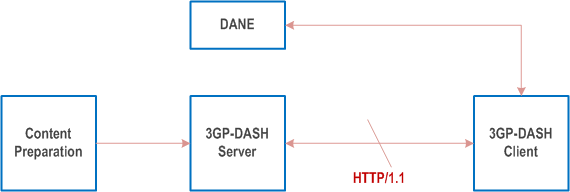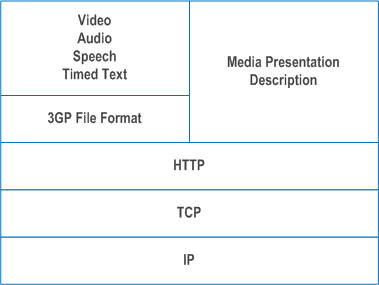Content for TS 26.247 Word version: 18.1.0
4 Overview
5 System Description
5.1 Overview
5.2 Service Access
5.3 Protocols
6 Progressive Download over HTTP
6.1 General
6.2 Progressive Download
6.3 3GPP File Format Profiles
...
...
4 Overview p. 14
The present document specifies Progressive Download and Dynamic Adaptive Streaming over HTTP (3GP-DASH) for continuous media. The features are separated from the umbrella specification TS 26.234 to differentiate from RTP-based streaming that is specified and maintained in TS 26.234. Services relying exclusively on these features may be deployed independently from RTP-based PSS servers, for example by using standard HTTP/1.1 servers for hosting the services and in particular also for 5G Media Downlink Streaming when content is hosted on 5GMSd ASs as defined in the stage 2 specification in TS 26.501 as well as in the stage 3 specifications in TS 26.511 and TS 26.512.
The specification covers the following aspects:
- System Description: describes the relationship to the PSS architecture and refines the architecture, interfaces and protocols that are defined in this specification.
- Progressive Download over HTTP.
- 3GPP Dynamic Adaptive Streaming over HTTP (3GP-DASH) provides an overview of the architecture, the formats and the models that build the basis for 3GP-DASH. Also, 3GP-DASH Profiles provide identifiers and refers to a set of specific restrictions in this or other specifications.
- DASH - Media Presentation describes the data model of a Media Presentation. It also provides an overview on elements and attributes that may be used to describe components and properties of a media presentation in a Media Presentation Description (MPD).
- DASH - Usage of the 3GP file format defines how segments can be formed based on the 3GP file format.
- Quality-of-Experience for Progressive Download and 3GP-DASH.
- Server and Network Assisted DASH (SAND) introduces messages between DASH clients and network elements or between various network elements for the purpose to improve efficiency of streaming sessions by providing information about real-time operational characteristics of networks, servers, proxies, caches as well as DASH client's performance and status.
- Normative annexes for MPD schema (Annex B), Descriptor Scheme Definitions (Annex C), OMA DM QoE Management Object (Annex F), File format extensions for 3GPP DASH support (Annex G) and MIME Type Registration for MPD (Annex H).
- Informative annexes for Client Behaviour (Annex A), MPD Examples (Annex D), and Mapping MPD structure and semantics to SMIL (Annex E).
5 System Description p. 15
5.1 Overview p. 15
Progressive Download and Dynamic Adaptive Streaming over HTTP (3GP-DASH) enables to provide services to deliver continuous media content over Hypertext Transfer Protocol (HTTP) in a sense that all resources that compose the service are accessible through HTTP-URLs and the HTTP/1.1 protocol as specified in RFC 9112 may be used to deliver the metadata and media data composing the service. This enables that standard HTTP servers and standard HTTP caches can be used for hosting and distributing continuous media content. Figure 1 shows the architecture for services using progressive download and Figure 2 shows the architecture for services using 3GP-DASH.
The present document deals with the specification of interfaces between the Client and the Server. Specifically, it defines the formats that may be delivered exclusively over the HTTP interface to enable progressive download and streaming services.

Services using the features described in this specification may be deployed within PSS as specified in TS 26.233 and TS 26.234. In this case the Progressive Download/3GP-DASH Server may be a sub-function of the PSS server and the Progressive Download/3GP-DASH client may be a sub-function of the PSS client.

Services using the features defined in this specification may also be deployed independent of the PSS servers and clients. In this case the Progressive Download/3GP-DASH client shall support the formats and codecs according to this specification.
Access to services based on the features defined in the present document is introduced in clause 5.2.
The protocol support for services using the features defined in this specification is provided in clause 5.3.
Clients supporting progressive download-based services shall support the features and formats as specified in clause 6 of this specification.
Clients supporting 3GP-DASH shall support the features and formats as specified in clause 7 of this specification.
Clients supporting QoE Metrics and Reporting shall support the features as specified in clause 10 of this specification.
Clients supporting SAND functionality shall support the features as specified in clause 13 of this specification. Figure 2a shows the extended architecture for services for 3GP-DASH using SAND. The new interface between the DASH-Aware Network Element (DANE) and 3GP-DASH enables the SAND functionality.

5.2 Service Access p. 16
Service access refers to the method by which a Client initially accesses the service. Service access for services based in the specification can be achieved e.g. by a Media Presentation Description or a URL to the media file.
The service access URL can be made available to a client in many different ways. Clients supporting services based on the features in this specification shall be able to access services that are provided through an HTTP-URL. However, it is out of the scope of this specification to mandate any specific mechanism. A preferred way may be to embed URLs for service establishment within HTML pages.
5.3 Protocols p. 16
5.3.1 General |R13| p. 16
Progressive Download and 3GP-DASH clients shall comply with a client as specified in RFC 9112. The resource hosting the 3GP files and DASH Segments shall comply with a server as specified in RFC 9112.
Progressive Download and 3GP-DASH clients should use the HTTP GET method or the HTTP partial GET method, as specified in Section 9.3 of RFC 9112, to access media offered at HTTP-URLs.
Figure 3 shows a protocol stack for services in the context of this specification. 3GP Files in progressive download as well as Segments based on the 3GPP File Format shall be accessible through HTTP.

Transport security in Progressive Download and Dynamic Adaptive Streaming over HTTP (3GP-DASH) is achieved using the HTTPS (Hypertext Transfer Protocol Secure) specified in RFC 2818 and TLS as specified in TLS profile of Annex E in TS 33.310. In case secure delivery is desired, HTTPS should be used to authenticate the server and to ensure secure transport of the content from server to client.
5.3.2 Partial File Handling |R13| p. 17
In certain cirumstances, for example in the case of MBMS download delivery of 3GP-DASH content, a file or segment may only be partially available on the HTTP server.
If the application, i.e. the 3GP file format client or the 3GP-DASH client supports the handling of partial files, it shall signal its capability using the partial-file-accept request defined in clause 7.9.2.1 of TS 26.346, i.e. using the Accept header application/3gpp-partial in combination with e.g. an HTTP GET request. If the application uses a partial-file-accept request, then the application shall also be able to handle the request response as defined in clause 7.9.2.2 of TS 26.346.
If the 3GP file format server or the 3GP-DASH server supports the handling of partial files, it should support the HTTP response format as defined in clause 7.9.2.2 of TS 26.346.
6 Progressive Download over HTTP p. 17
6.1 General p. 17
As an alternative to conventional streaming, a client may download, typically through HTTP, a media file that encapsulates continuous media and may play the media from the local storage. A PSS client shall support progressive download and playout of 3GP files [4] as specified in the remainder of this clause.
The media file encapsulating the continuous media is accessed directly by issuing one or more HTTP GET or partial GET requests to the referenced media file. An example of a valid URL is http://example.com/morning_news.3gp .
6.2 Progressive Download p. 17
Progressive download uses normal HTTP download using HTTP GET or partial GET requests. The differences between regular download and Progressive Download are that 1) the content may be authored as progressively downloadable, and 2) the terminal recognises that the content is suitable for progressive download.
A client downloading continuous media may decide to start playout of the encapsulated media data before the download of the media file is completed.
6.3 3GPP File Format Profiles p. 17
The following profiles of the 3GPP file format in TS 26.244 shall be supported by clients supporting Progressive Download over HTTP:
- Basic profile, and
- Progressive-download profile.